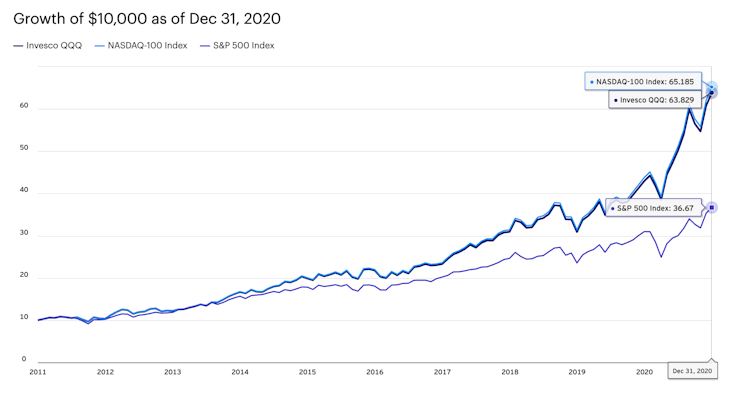3 Reasons to Trade the E-mini Nasdaq-100
The Nasdaq-100 has outperformed the much larger S&P 500 over the past 10 years. Exposure in the technology sector and instant diversification, among others, can be attractive reasons why you should trade the E-mini Nasdaq-100.
The Nasdaq-100 is an index of the 100 largest non-financial companies listed on the Nasdaq stock exchange based on market capitalization. It began on January 31, 1985 at a base value of 125 and mainly serves as a benchmark for US technology stocks, although it also includes companies in other sectors.
1. Invest in the Technology Sector
The Nasdaq-100 is a great way to gain exposure to the US technology sector without having to analyze the financials of individual companies. It’s not strictly a technology-only index as it includes companies in sectors such as retail, industrial, biotechnology, and health. But it explicitly does not contain financial companies including investment companies.
Like other global stock market indices, the Nasdaq-100 tracks a basket of individual companies and weighs them by their market capitalization.
The index is rebalanced on a quarterly basis in March, June, September, and December. Rebalancing keeps the index relevant with eligible companies. Over the last 10 years, the Nasdaq-100 has increased six-fold and outperformed the S&P 500 by a wide margin.
You can trade an exchange-traded fund (ETF) like the Invesco QQQ ETF (ticker symbol QQQ) to invest in the Nasdaq-100 long term. Since its formation in 1999, the QQQ replicates the performance of the index and ranks in the top 1% of large-cap growth funds.

2. Instant Diversification
It’s needless to say that long-term investors should hold a diversified portfolio of stocks. Analyzing which companies to invest in can often become a time-consuming activity that the average investor may not be able to handle.
Mutual funds have been a useful investment vehicle thus far. These funds allow investors to achieve diversification across many different assets in one simple holding and they take a lot of the guesswork out of building your portfolio. With the rise in popularity of ETFs you can achieve the same, often with much lower fees.
If you’re looking for a balanced ETF that offers built-in diversification in 100 of the largest non-financial stocks by market capitalization, look no further than the QQQ. It has an expense ratio of 0.20%.
A big advantage of trading the QQQ over other identical, cheaper options, is its high liquidity. The average daily volume is 50 million shares which means that your trades go through with a spread of just a penny between bids and offers. Long-term investors can be sure to purchase or liquidate at the best possible market price. Traders can use it to make short-term bets and harvest gains with low trading costs.
3. Hedge Bear Markets With Futures
As soon as you invest in the stock market long-term, you will regularly experience corrections. They generally range between 5% and 20% and last a couple of months. When the dot-com bubble burst in March 2000, the Nasdaq Composite fell as much as 78% for over two years.
While huge losses are rare, corrections do impact your performance and can leave you in the red for an extended period of time. Hedging strategies are therefore a highly underrated skill and should be used by investors who want to stabilize their portfolios.
The E-mini Nasdaq-100 (NQ) was made precisely for efficient portfolio hedging. Brokerages generally charge very low trading fees and you can hedge with low margin requirements. If your portfolio is primarily technology-based, the NQ is your ideal instrument for hedging market corrections. Smaller portfolios can be hedged with the new Micro E-mini Nasdaq-100 (MNQ).
Another advantage of hedging with the E-mini Nasdaq-100 is that they settle in cash daily which means that proceeds from your short position can be used to buy stocks when they are at their lows. You’re now benefiting from corrections.
Matt Hagemann
March 19, 2021